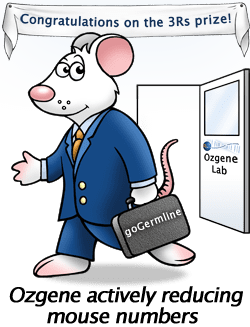Shedding light on EPP
Shedding light on EPP
In this issue
Feature
ISTT 3Rs prize
Latest publications
Frank’s blog
Timeline update
Shedding light on EPP
While most of us enjoy a sunny day, people suffering from erythropoietic protoporphyria (EPP) have a less pleasant experience. EPP is a rare metabolic disorder caused by deficiency of ferrochelatase (FECH), which would normally add iron to protoporphyrin to convert it into haem. Haem is best known as a component of hemoglobin but is also found in other hemoproteins. FECH deficiency leads to the build-up of protoporphyrin in the blood. As blood passes through the skin, the protoporphyrin absorbs the energy from sunlight, triggering a phototoxic reaction that causes itching and severe pain. Longer light exposure can lead to swelling and skin ulcers. EPP varies in severity; 5% of the patients develop a liver dysfunction as a result of protoporphyrin accumulation. There is currently no cure for EPP.
A research team at the Triemli Hospital in Zurich, Switzerland, with key members Prof. Dr. Elisabeth Minder, Prof. Dr. Xiaoye Schneider-Yin and Dr. Jasmin Barman-Aksözen focus on EPP studies. The occurrence of EPP is very rare, affecting only one person in 150,000, and the symptoms are not recognised by most physicians. The research team have developed an analysis and diagnostic procedure to identify EPP and monitor the progress of the disease. They further aim to reveal the hereditary mechanisms and molecular genetic causes for EPP.
In their recent ‘Disease Models & Mechanisms’ paper, the Triemli Hospital research team introduce the first EPP mouse model that represents the human inheritance pattern. The majority of EPP patients have a severe, debilitating FECH mutation in combination with a splice modulating polymorphism in trans, c.315-48C polymorphism. Together, they reduce ferrochelatase synthesis under a critical threshold. A mouse model with partly humanized Fech gene with the c.315-48C polymorphism was generated in collaboration with Ozgene. The Triemli team then joined forces with researchers at the ETH Zurich und the University of Berne and crossed these mice with a mouse line carrying a severe m1Pas Fech mutation. The resulting mouse model shows a very strong EPP phenotype, representing an important step towards pre-clinical testing of EPP therapies.
For more information on the EPP research, read the publication below and visit the Triemli Hospital website.
For information on Ozgene mouse models, visit Ozgene services.
goGermline wins ISTT 3Rs prize
The International Society for Transgenic Technologies (ISTT) has selected goGermline as the winner of the inaugural ISTT 3Rs prize. According to ISTT, the widespread application of goGermline can have a significant impact on 3Rs in relation to the use of animals for scientific research. You still have until 31 August to take advantage of our ISTT 3Rs prize special which gives you free 12-month cryopreservation with any full KO or KI project.
Latest publications
FEATURED – Dis Model Mech. 2017 Jan 12.
Modelling the ferrochelatase c.315-48C modifier mutation for erythropoietic protoporphyria (EPP) in mice.
Barman-Aksözen J, C Wiek P, Bansode VB, Koentgen F, Trüb J, Pelczar P, Cinelli P, Schneider-Yin X, Schümperli D, Minder EI. – Municipal Hospital Triemli, Zurich; University of Bern; University of Basel; University Hospital Zurich, Switzerland. Ozgene Pty Ltd, Perth, Australia. [read]
Nat Genet. 2017 Aug.
The methyltransferase SETDB1 regulates a large neuron-specific topological chromatin domain.
Jiang Y, Loh YE, Rajarajan P, Hirayama T, Liao W, Kassim BS, Javidfar B, Hartley BJ, Kleofas L, Park RB, Labonte B, Ho SM, Chandrasekaran S, Do C, Ramirez BR, Peter CJ, C W JT, Safaie BM, Morishita H, Roussos P, Nestler EJ, Schaefer A, Tycko B, Brennand KJ, Yagi T, Shen L, Akbarian S. – Icahn School of Medicine at Mount Sinai; New York Genome Center; Columbia University; James J. Peters Virginia Medical Center, New York, USA. Graduate School of Frontier Biosciences, Osaka University, Suita, Japan. [read]
J Clin Invest. 2017 Aug 1.
Biallelic mutations in the ubiquitin ligase RFWD3 cause Fanconi anemia.
Knies K, Inano S, Ramírez MJ, Ishiai M, Surrallés J, Takata M, Schindler D. – University of Wurzburg, Germany. Kyoto University, Japan. Universitat Autònoma de Barcelona; Center for Biomedical Network Research on Rare Diseases (CIBERER), Madrid; Hospital de Sant Pau, Barcelona, Spain. [read]

Lean – an objective or intersubjective reality?
Frank’s blog – A friend of mine asked recently: “What do you want me to present at a Lean conference?” I suggested to discuss “What is Lean?”. This is because I have an ongoing dilemma with continuous improvement (CI) frameworks such as Lean, Operational Excellence, TPS etc. When asking for the lead time to implement Lean, the perplexing answer is that it takes 5-10 years. In addition, a second dilemma is that there are many thoughts on how to implement Lean, depending on your Lean coach, consultant or sensei.





